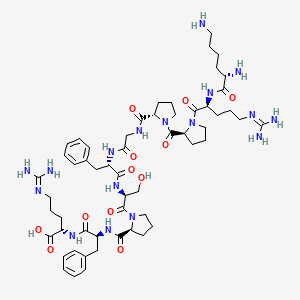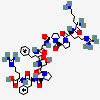Kallidin
PubChem CID
5311111
Molecular Formula
Synonyms
- KALLIDIN
- Lys-Bradykinin
- 342-10-9
- Lysyl-bradykinin
- Lysylbradykinin
Molecular Weight
1188.4 g/mol
Computed by PubChem 2.2 (PubChem release 2021.10.14)
Dates
- Create:2005-12-16
- Modify:2025-01-18
Description
Kallidin is a peptide.
A decapeptide bradykinin homolog cleaved from kininogen by kallikreins. It is a smooth-muscle stimulant and hypotensive agent that acts by vasodilatation.
Chemical Structure Depiction

Conformer generation is disallowed since too many atoms, too flexible
SVG Image

IUPAC Condensed
H-Lys-Arg-Pro-Pro-Gly-Phe-Ser-Pro-Phe-Arg-OH
Sequence
KRPPGFSPFR
PLN
H-KRPPGFSPFR-OH
HELM
PEPTIDE1{K.R.P.P.G.F.S.P.F.R}$$$$
IUPAC
L-lysyl-L-arginyl-L-prolyl-L-prolyl-glycyl-L-phenylalanyl-L-seryl-L-prolyl-L-phenylalanyl-L-arginine
(2S)-2-[[(2S)-2-[[(2S)-1-[(2S)-2-[[(2S)-2-[[2-[[(2S)-1-[(2S)-1-[(2S)-2-[[(2S)-2,6-diaminohexanoyl]amino]-5-(diaminomethylideneamino)pentanoyl]pyrrolidine-2-carbonyl]pyrrolidine-2-carbonyl]amino]acetyl]amino]-3-phenylpropanoyl]amino]-3-hydroxypropanoyl]pyrrolidine-2-carbonyl]amino]-3-phenylpropanoyl]amino]-5-(diaminomethylideneamino)pentanoic acid
Computed by Lexichem TK 2.7.0 (PubChem release 2021.10.14)
InChI=1S/C56H85N17O12/c57-24-8-7-18-36(58)46(76)67-37(19-9-25-63-55(59)60)51(81)73-29-13-23-44(73)53(83)72-28-11-21-42(72)49(79)65-32-45(75)66-39(30-34-14-3-1-4-15-34)47(77)70-41(33-74)52(82)71-27-12-22-43(71)50(80)69-40(31-35-16-5-2-6-17-35)48(78)68-38(54(84)85)20-10-26-64-56(61)62/h1-6,14-17,36-44,74H,7-13,18-33,57-58H2,(H,65,79)(H,66,75)(H,67,76)(H,68,78)(H,69,80)(H,70,77)(H,84,85)(H4,59,60,63)(H4,61,62,64)/t36-,37-,38-,39-,40-,41-,42-,43-,44-/m0/s1
Computed by InChI 1.0.6 (PubChem release 2021.10.14)
FYSKZKQBTVLYEQ-FSLKYBNLSA-N
Computed by InChI 1.0.6 (PubChem release 2021.10.14)
C1C[C@H](N(C1)C(=O)[C@@H]2CCCN2C(=O)[C@H](CCCN=C(N)N)NC(=O)[C@H](CCCCN)N)C(=O)NCC(=O)N[C@@H](CC3=CC=CC=C3)C(=O)N[C@@H](CO)C(=O)N4CCC[C@H]4C(=O)N[C@@H](CC5=CC=CC=C5)C(=O)N[C@@H](CCCN=C(N)N)C(=O)O
Computed by OEChem 2.3.0 (PubChem release 2024.12.12)
C56H85N17O12
Computed by PubChem 2.2 (PubChem release 2021.10.14)
342-10-9
- Bradykinin, Lysine
- Bradykinin, Lysyl
- Kallidin
- Kallidin Tetraacetate
- Kallidin, (D)-Isomer
- Lys Bradykinin
- Lys-Bradykinin
- Lysine Bradykinin
- Lysyl Bradykinin
- N2 L Lysylbradykinin
- N2-L-Lysylbradykinin
- Tetraacetate, Kallidin
- KALLIDIN
- Lys-Bradykinin
- 342-10-9
- Lysyl-bradykinin
- Lysylbradykinin
- [Lys]bradykinin
- Lys-BK
- kallidin II
- Bradykinin, Lysine
- Bradykinin, N2-L-lysyl-
- (2S)-2-[[(2S)-2-[[(2S)-1-[(2S)-2-[[(2S)-2-[[2-[[(2S)-1-[(2S)-1-[(2S)-2-[[(2S)-2,6-diaminohexanoyl]amino]-5-(diaminomethylideneamino)pentanoyl]pyrrolidine-2-carbonyl]pyrrolidine-2-carbonyl]amino]acetyl]amino]-3-phenylpropanoyl]amino]-3-hydroxypropanoyl]pyrrolidine-2-carbonyl]amino]-3-phenylpropanoyl]amino]-5-(diaminomethylideneamino)pentanoic acid
- UNII-0T8T4A440G
- EINECS 206-438-0
- (Lys)bradykinin
- DTXSID40895018
- 0T8T4A440G
- 2-[[2-[[1-[2-[[2-[[2-[[1-[1-[2-(2,6-diaminohexanoylamino)-5-(diaminomethylideneamino)pentanoyl]pyrrolidine-2-carbonyl]pyrrolidine-2-carbonyl]amino]acetyl]amino]-3-phenylpropanoyl]amino]-3-hydroxypropanoyl]pyrrolidine-2-carbonyl]amino]-3-phenylpropanoyl]amino]-5-(diaminomethylideneamino)pentanoic acid
- N2-L-Lysylbradykinin
- Lys Bradykinin
- Lysyl Bradykinin
- Lysine Bradykinin
- Bradykinin, Lysyl
- (2S)-2-[[(2S)-2-[[(2S)-1-[(2S)-2-[[(2S)-2-[[2-[[(2S)-1-[(2S)-1-[(2S)-2-[[(2S)-2,6-diaminohexanoyl]amino]-5-guanidino-pentanoyl]pyrrolidine-2-carbonyl]pyrrolidine-2-carbonyl]amino]acetyl]amino]-3-phenyl-propanoyl]amino]-3-hydroxy-propanoyl]pyrrolidine-2-carbonyl]amino]-3-phenyl-propanoyl]amino]-5-guanidino-pentanoic acid
- N2 L Lysylbradykinin
- (2S)-2-(((2S)-2-(((2S)-1-((2S)-2-(((2S)-2-((2-(((2S)-1-((2S)-1-((2S)-2-(((2S)-2,6-diaminohexanoyl)amino)-5-(diaminomethylideneamino)pentanoyl)pyrrolidine-2-carbonyl)pyrrolidine-2-carbonyl)amino)acetyl)amino)-3-phenylpropanoyl)amino)-3-hydroxypropanoyl)pyrrolidine-2-carbonyl)amino)-3-phenylpropanoyl)amino)-5-(diaminomethylideneamino)pentanoic acid
- (2S)-2-(((2S)-2-(((2S)-1-((2S)-2-(((2S)-2-((2-(((2S)-1-((2S)-1-((2S)-2-(((2S)-2,6-diaminohexanoyl)amino)-5-guanidino-pentanoyl)pyrrolidine-2-carbonyl)pyrrolidine-2-carbonyl)amino)acetyl)amino)-3-phenyl-propanoyl)amino)-3-hydroxy-propanoyl)pyrrolidine-2-carbonyl)amino)-3-phenyl-propanoyl)amino)-5-guanidino-pentanoic acid
- KALLIDIN [MI]
- KALLIDIN-10
- GTPL650
- SCHEMBL150645
- CHEBI:6102
- FYSKZKQBTVLYEQ-FSLKYBNLSA-N
- DTXCID501324577
- AKOS024457492
- Lys-Arg-Pro-Pro-Gly-Phe-Ser-Pro-Phe-Arg
- HY-103293
- CS-0027229
- C01505
- Q2398786
- L-ARGININE, L-LYSYL-L-ARGINYL-L-PROLYL-L-PROLYLGLYCYL-L-PHENYLALANYL-L-SERYL-L-PROLYL-L-PHENYLALANYL-
Property Name
Property Value
Reference
Property Name
Molecular Weight
Property Value
1188.4 g/mol
Reference
Computed by PubChem 2.2 (PubChem release 2021.10.14)
Property Name
XLogP3-AA
Property Value
-5.3
Reference
Computed by XLogP3 3.0 (PubChem release 2021.10.14)
Property Name
Hydrogen Bond Donor Count
Property Value
14
Reference
Computed by Cactvs 3.4.8.18 (PubChem release 2021.10.14)
Property Name
Hydrogen Bond Acceptor Count
Property Value
16
Reference
Computed by Cactvs 3.4.8.18 (PubChem release 2021.10.14)
Property Name
Rotatable Bond Count
Property Value
33
Reference
Computed by Cactvs 3.4.8.18 (PubChem release 2021.10.14)
Property Name
Exact Mass
Property Value
1187.65636121 Da
Reference
Computed by PubChem 2.2 (PubChem release 2021.10.14)
Property Name
Monoisotopic Mass
Property Value
1187.65636121 Da
Reference
Computed by PubChem 2.2 (PubChem release 2021.10.14)
Property Name
Topological Polar Surface Area
Property Value
474 Ų
Reference
Computed by Cactvs 3.4.8.18 (PubChem release 2021.10.14)
Property Name
Heavy Atom Count
Property Value
85
Reference
Computed by PubChem
Property Name
Formal Charge
Property Value
0
Reference
Computed by PubChem
Property Name
Complexity
Property Value
2330
Reference
Computed by Cactvs 3.4.8.18 (PubChem release 2021.10.14)
Property Name
Isotope Atom Count
Property Value
0
Reference
Computed by PubChem
Property Name
Defined Atom Stereocenter Count
Property Value
9
Reference
Computed by PubChem
Property Name
Undefined Atom Stereocenter Count
Property Value
0
Reference
Computed by PubChem
Property Name
Defined Bond Stereocenter Count
Property Value
0
Reference
Computed by PubChem
Property Name
Undefined Bond Stereocenter Count
Property Value
0
Reference
Computed by PubChem
Property Name
Covalently-Bonded Unit Count
Property Value
1
Reference
Computed by PubChem
Property Name
Compound Is Canonicalized
Property Value
Yes
Reference
Computed by PubChem (release 2021.10.14)
Follow these links to do a live 2D search or do a live 3D search for this compound, sorted by annotation score. This section is deprecated (see here for details), but these live search links provide equivalent functionality to the table that was previously shown here.
Same Connectivity Count
Same Parent, Connectivity Count
Same Parent, Exact Count
Mixtures, Components, and Neutralized Forms Count
Similar Compounds (2D)
Similar Conformers (3D)
Antihypertensive Agents
Drugs used in the treatment of acute or chronic vascular HYPERTENSION regardless of pharmacological mechanism. Among the antihypertensive agents are DIURETICS; (especially DIURETICS, THIAZIDE); ADRENERGIC BETA-ANTAGONISTS; ADRENERGIC ALPHA-ANTAGONISTS; ANGIOTENSIN-CONVERTING ENZYME INHIBITORS; CALCIUM CHANNEL BLOCKERS; GANGLIONIC BLOCKERS; and VASODILATOR AGENTS. (See all compounds classified as Antihypertensive Agents.)
Vasodilator Agents
Drugs used to cause dilation of the blood vessels. (See all compounds classified as Vasodilator Agents.)
- ChEBI
- ChemIDplusChemIDplus Chemical Information Classificationhttps://pubchem.ncbi.nlm.nih.gov/source/ChemIDplus
- EPA DSSToxCompTox Chemicals Dashboard Chemical Listshttps://comptox.epa.gov/dashboard/chemical-lists/
- European Chemicals Agency (ECHA)LICENSEUse of the information, documents and data from the ECHA website is subject to the terms and conditions of this Legal Notice, and subject to other binding limitations provided for under applicable law, the information, documents and data made available on the ECHA website may be reproduced, distributed and/or used, totally or in part, for non-commercial purposes provided that ECHA is acknowledged as the source: "Source: European Chemicals Agency, http://echa.europa.eu/". Such acknowledgement must be included in each copy of the material. ECHA permits and encourages organisations and individuals to create links to the ECHA website under the following cumulative conditions: Links can only be made to webpages that provide a link to the Legal Notice page.https://echa.europa.eu/web/guest/legal-noticeBradykinin, N2-l-lysyl-https://echa.europa.eu/substance-information/-/substanceinfo/100.005.853
- Comparative Toxicogenomics Database (CTD)LICENSEIt is to be used only for research and educational purposes. Any reproduction or use for commercial purpose is prohibited without the prior express written permission of NC State University.http://ctdbase.org/about/legal.jsp
- Drug Gene Interaction database (DGIdb)LICENSEThe data used in DGIdb is all open access and where possible made available as raw data dumps in the downloads section.http://www.dgidb.org/downloads1-PALMITOYL-LYSOPHOSPHATIDYLCHOLINEhttps://www.dgidb.org/drugs/iuphar.ligand:5650COMPOUND 20 [PMID:12127536]https://www.dgidb.org/drugs/iuphar.ligand:8650
- IUPHAR/BPS Guide to PHARMACOLOGYLICENSEThe Guide to PHARMACOLOGY database is licensed under the Open Data Commons Open Database License (ODbL) https://opendatacommons.org/licenses/odbl/. Its contents are licensed under a Creative Commons Attribution-ShareAlike 4.0 International License (http://creativecommons.org/licenses/by-sa/4.0/)https://www.guidetopharmacology.org/about.jsp#licenseGuide to Pharmacology Target Classificationhttps://www.guidetopharmacology.org/targets.jsp
- Therapeutic Target Database (TTD)
- Japan Chemical Substance Dictionary (Nikkaji)
- KEGGLICENSEAcademic users may freely use the KEGG website. Non-academic use of KEGG generally requires a commercial licensehttps://www.kegg.jp/kegg/legal.htmlBioactive peptideshttp://www.genome.jp/kegg-bin/get_htext?br08005.keg
- Metabolomics Workbench
- Wikidata
- WikipediaOxyphenbutazonehttps://en.wikipedia.org/wiki/Oxyphenbutazone
- Medical Subject Headings (MeSH)LICENSEWorks produced by the U.S. government are not subject to copyright protection in the United States. Any such works found on National Library of Medicine (NLM) Web sites may be freely used or reproduced without permission in the U.S.https://www.nlm.nih.gov/copyright.htmlAntihypertensive Agentshttps://www.ncbi.nlm.nih.gov/mesh/68000959Vasodilator Agentshttps://www.ncbi.nlm.nih.gov/mesh/68014665
- PubChem
- MolGenieMolGenie Organic Chemistry Ontologyhttps://github.com/MolGenie/ontology/
CONTENTS
